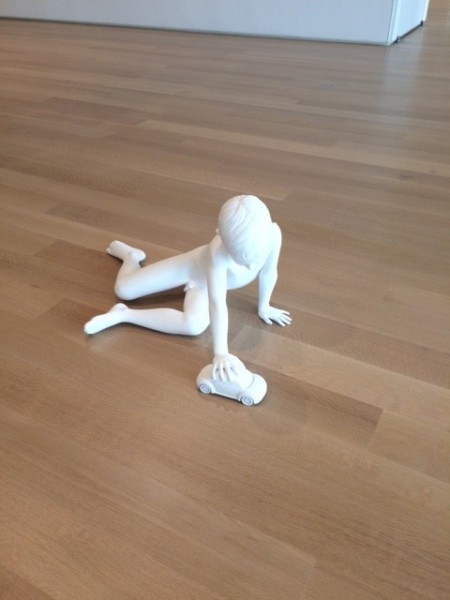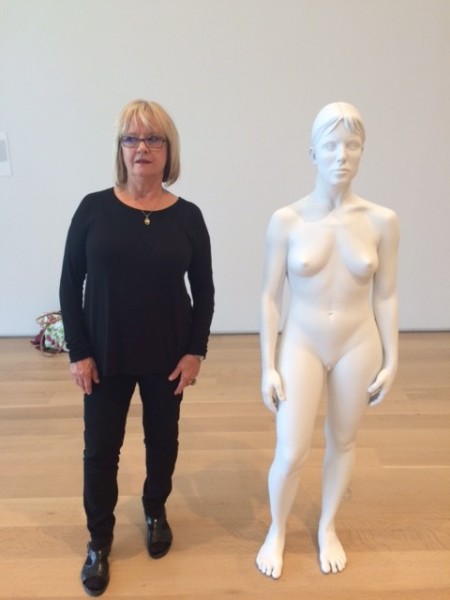Midwest-born, Los Angeles–based sculptor Charles Ray’s mid-career retrospective, “Charles Ray: Sculpture, 1997–2014,” is a significant and revelatory exhibition which opened at the Art Institute of Chicago May 15, 2015 and concluded on October 4. The exhibition was co-organized by the Art Institute, its only North American venue, and the Kunstmuseum, Basel. Six of Ray’s sculptures—including four new works in their museum debut: Horse and Rider, Huck and Jim, (huge, nude, controversial) Silver, (woof) and Girl on Pony—are on view only in Chicago. Charles Ray frequently honors ancient Greek kouros or kore, nude statues of male and female youth, so it is ironic I was in Greece this summer viewing a lot of these magnificent representations of the human figure, so I could not write and tell readers to see this exhibition this summer.
Here are some of the questions the Charles Ray exhibition calls up: what is the first sculptural representation of the human figure? Is it female? A fertility goddess? When we think of powerful representations of the human figure, what is in the “museum in our heads?” King Tut? The Alexander the Great full-body marble statue in Istanbul? Christ on the cross? Michelangelo’s Pieta? The soulful bronze of Abraham Lincoln by Daniel Chester French in Washington, D. C.? The Mount Rushmore National Monument? Does our mind jump to the TV footage of the toppling of the bronze statue of Iraq’s former leader, Saddam Hussein? See what I mean. Sculptures of the human figure are central to our understanding of ourselves. The ancients understood this. So does English artist Damien Hirst, who purchased a skull dating between 1720 – 1810, and with a consortium of buyers/collectors studded it with flawless pavé-set diamonds, weighing a massive 1,106.18 carats. Hirst’s piece, For the Love of God, is essentially an assemblage, not a strict sculpture, since the skull was a “found object”, but you get my point. He selected a human head: The tenderness of a Brancusi bronze Head replaced by costly flash and machismo.
So here is Charles Ray, having entered the fray. Think of the significant artists from the twentieth century until now who have weighed in on the representation of the human figure. A partial list includes Henri Matisse, Elie Nadelman, Gaston Lachaise, Henry Moore, Brancusi, Gertrude Vanderbilt Whitney, Louise Bourgeois, Magdalena Abakanowicz, Robert Gober, Kiki Smith, Duane Hanson, Mary Frank, Stephen Bankenol, Nick Cave, (the performance artist) and Jeff Koons.
Immediately upon entering the spare and elegant exhibition space, you can’t help but notice the sexual aspects of Charles Ray’s sculptures, especially with so much male genitalia. Maybe Charles Ray is a feminist since he doesn’t focus on the female and pudenda. He shows an abundance of male genitalia, with balls always hanging free in the breeze. Feminist or narcissist? I say narcissist since I think the nude male sculptures are a stand-in for Ray himself, particularly the one of him nude tying his shoe while jogging in the hills of California. He doesn’t actually jog nude, that surely would be awkward, but he chose to solidify (literally) the simple act of bending down to tie one’s shoelace, though while nude. So I say to myself, “Self, is this important?” I say, “No.” Like Koons and Hirst, Ray goes for that Post This, Post That gesture. It is ironic and has not been done before! Is it worth the high price of fabrication? The ancient Dying Gaul was historically relevant in its time and is still timeless, the nude soldier hunched over, dying. Charles Ray’s nude self-portrait sculpture is also hunched over….as if tying his gym shoe.
Another example of what I see as self-portraiture in this exhibition is the Boy With Frog. This is the original Venice commission of an eight-foot-tall boy holding a wriggling frog that was commissioned by François Pinault, the French luxury goods magnate and collector who has a vaulted presence in Venice and with special exhibitions during the run of the Venice Biennale. Boy With Frog is white-painted stainless like several works in this exhibition. Regretfully, it was removed from Venice after a four-year run. It seems awkward that Pinault would commission a site-specific work to be on a space that was up for lease-renewal from the city of Venice every four years, but after the first four-year run, city fathers sought to remove the boy and frog and return a replica 19th century lamp post back in place. Is the boy Ray, or any boy on the cusp of manhood? Is the frog his phallus, still limp in childhood, not yet ready to leap into manhood? That piece is so sexual and fraught with anxiety I am amazed it was commissioned for Venice. A long discussion could also be made of the use of Ray’s white-painted sculptures, a stand-in for ancient sculptures in their current surviving state, and for the use of cool-toned monochrome, such as stainless steel. All ancient sculptures were originally highly colored (polychromed) in reds, yellows, blues and greens and many were decorated with ivory, gold leaf, and bronze decorative embellishments. They were the vivid realism of their day. We forget this.
Much is made of the technical accomplishments of Ray’s work and this too calls to mind the legion of fabricators assisting Jeff Koons and all those who set the 1,106.18 carats of diamonds in Hirst’s For the Love of God. The sculpture world has been tremendously competitive with fabricating feats for a long time now. Robert Smithson is surely turning in his grave. Is this a current male thing, to be so technically astounding, with such perfectly fabricated steel sculptures of cast or computer-calibrated figures? I think of technically-brilliant feats, such as Audrey Flack painting her super-airbrushed Marilyns and Marilyn Minter’s glitzy, dizzy paintings too. But for sculptors, the women sculptors of note weigh in on the body as vulnerable and psychically-charged (Louis Bourgeois, Magdalena Abakanowicz, Kiki Smith.) So what I really appreciated about viewing and thinking about the Ray exhibition is to contemplate how we are wrangling with the figure now. Who cares if Ray apparently has been pioneering the use of solid, machined aluminum and stainless steel? We can’t tell these sculptures of various figures weigh tons and tons (as the wall text states.) Ray is obsessive, but to what end? How does it feel to walk around and soak up all this stainless steel, some of it painted white, looking as thin as an eggshell? It feels empty to me. This is my first rather negative review, as I am given to celebrating art and finding the best in artistic efforts. But here I wonder why Ray, who choses his subjects so carefully, and spends an enormous amount of time in researching his replication methods, doesn’t go for raising the temperature in the room? These are, after all, human figures.
–Cynthia Kukla is an artist and art critic living in Illinois











October 28th, 2015at 1:49 pm(#)
Great review. Love the last photo of you, looking as skeptical as your review is, in black with the similarly sized female nude in white.
I haven’t seen the exhibition, but agree that it seems cold. I’d like to see similar work executed in life-sized plaster multiples, placed in random or in what would be more – meaningful groups. That or executed in some other less high tech (and expensive) medium. Of course the price such work commands is possibly as meaningful to the artist as the work itself. And it will last 1,000 years (ha).
What do these sculptures inform us of? Guess you’d have to “be there” to answer this question…